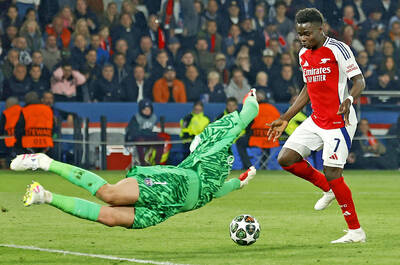It's the moment when World Cup dreams are realized or cruelly shattered.
In a split-second moment, you're either hero or villain.
In polls for worst World Cup penalty miss of all time, Roberto Baggio's ballooned effort in the 1994 final against Brazil is often voted top of the flops.
England's Stuart Pearce and Chris Waddle [against Germany in 1990] and Paul Ince and David Batty [against Argentina in 1998] run a close second.
Some say singer Diana Ross's miss at the 1994 opening ceremony in Chicago was the classic blunder.
But with the aid of science, some say, it's possible to take the perfect penalty and that knowledge will be useful now that the 2006 World Cup has reached the knock-out stages.
So many big matches these days are decided on the 10.97m place kick that sports physicists, psychologists and biomechanicians are often recruited to try to give an edge to striker and keeper.
no-lose situation
Penalties are no-lose situations for the keeper, because almost all of the pressure is on the striker.
Psychologists can enhance this advantage in a number of ways.
One of them is in training keepers in body language. Keepers who are alert to the kicker's eyes, body posture and angle of his feet in the runup can gain as much as half a second in which to move in the right direction.
Scientists at John Moores University in Liverpool showed goalkeepers life-sized video footage of penalties being taken, filmed from the viewpoint of a keeper standing in the center of the goal.
The film was stopped four times during the sequence -- 120 milliseconds before the kick; 40 milliseconds before; at the point of impact; and 40 milliseconds after -- and the goalkeepers were asked at each stage to predict where the ball was being placed.
The researchers found that the biggest clue was the position of the striker's hips just before the strike.
"If the taker's hips are square-on to the goalkeeper in a right-footed kicker, the penalty goes to the right-hand side of the goalkeeper," says the university's Mark Williams.
"If his hips are more `open', or angled away from the goalkeeper, the kick tends to go to the left of the keeper," he said.
But science can also help the penalty-taker, too.
A study in biomechanics carried out at the University of Bath in 2004 determined the maximum reach of a goalie's dive, regardless of his size.
`unsaveable zone'
It showed that, if the keeper stays on his line in accordance with the rules, 28 percent of the goal is an "unsaveable zone" that guarantees a score provided the ball is kicked accurately and with reasonable force.
Even if you can't kick accurately, blasting is still a pretty good option.
"Hit your penalties as hard as possible," advises Kassam. "Research indicates that a penalty struck at more than 20m per second (73kph) stands a greater chance of hitting the back of the net than a slower one, as a goalkeeper has less time to analyze visual clues and react."
Simple psychological tactics can also improve the success rate of a team in the all-important shootouts.
A 2000 study found that if the weakest players take their penalties earliest in the sequence, with the strongest last, there is a big improvement in the team's chances.
According to FIFA statistics, the kicker holds all the cards.
In the history of the tournament, 182 penalties have been awarded with 147 converted or 81 percent.
Thirty-five have been missed with 22 of those saved by the keeper.
That said, there is no substitute for practice.
In the days before computers and penalty specialists, the Hungarian great Ferenc Puskas used the simplest of techniques to ensure that he would slot home a penalty.
He would hang a disc 80cm below the crossbar and aim at it, again, again and again, until he got it right.

Freddie Freeman homered and drove in four runs, Shohei Ohtani also went deep and Roki Sasaki earned his first major league win as the Los Angeles Dodgers beat the Atlanta Braves 10-3 on Saturday night for their seventh straight victory. The Dodgers have won the first two games of the series to improve to 5-0 against Atlanta this year. Los Angeles’ three-game sweep at home early in the season left the Braves 0-7. Sasaki allowed three runs and six hits over five innings. The 23-year-old right-hander gave up a home run to Ozzie Albies, but received plenty of offensive support in his

INTER AWAIT: Superb saves by PSG ’keeper Gianluigi Donnarumma inspired the victory, as Arsenal were punished for misses, including one by Bukayo Saka Arsenal on Wednesday fell short on the big stage again as their painful UEFA Champions League semi-final exit against Paris Saint-Germain left Mikel Arteta to rue his club’s failure to provide him with enough attacking options. Arteta’s side were unable to reach the Champions League final for the first time in 19 years as PSG clinched a tense 2-1 win at Parc des Princes. Trailing 1-0 from last week’s first leg in London, the Gunners made a blistering start to the second leg, but could not convert their chances as Gianluigi Donnarumma’s superb saves inspired PSG’s 3-1 aggregate victory. Arsenal were punished for

Bayern Munich on Sunday were crowned German champions for the 34th time, giving striker Harry Kane his first major trophy, after second-placed Bayer 04 Leverkusen drew 2-2 at SC Freiburg. Bayern’s 3-3 draw at RB Leipzig on Saturday, when the Bavarians came from two goals down to take the lead before conceding a stoppage-time equalizer, meant defending Bundesliga champions Leverkusen needed to win at Freiburg to delay the title party. Leverkusen were two goals down before scoring twice in the final 10 minutes, but Xabi Alonso’s side could not find a third, as Bayern reclaimed the title at the first attempt after

THRILLER: Raphinha gave Barca a 3-2 lead with two minutes remaining of regular time, but Francesco Acerbi equalized the game in the second minute of added time Davide Frattesi on Tuesday fired Inter into the UEFA Champions League final with an extra-time winner that gave the Italians a stunning 4-3 triumph over Barcelona, 7-6 on aggregate. Italy midfielder Frattesi won a tie for the ages under a downpour in Milan when he lashed home in the 99th minute, sending a packed and rocking San Siro wild with joy. Simone Inzaghi’s team will face either Arsenal or Paris Saint-Germain at the end of this month in Munich, Germany, where they would feel they have a great chance to be crowned kings of Europe for a fourth time after